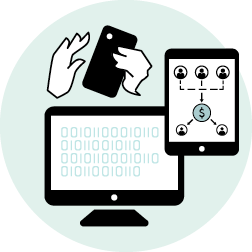“Data will talk to you if you’re willing to listen.” Jim Bergeson, marketing expert
Big data is just for big companies, right?
Wrong. Data collection and analysis isn’t a luxury meant only for large enterprises. Unless businesses both big and small track how their products and services are performing and what they’re costing, it’s impossible to know what’s working and what isn’t.
Sure, a smaller organization might collect less data, but that doesn’t mean it is any less critical to its operations. In fact, data might arguably be more important for small and mid-size businesses, since SMBs typically have fewer resources and need to pinpoint areas for improvement as quickly and accurately as possible to stay viable and competitive.
According to a recent Deloitte report, most SMBs observe benefits from using digital tools and the data they generate:
- 40% report that digital tools can help with customer growth
- 70% report improved financial performance
- 90% believe that digital tools have fostered innovation in their business
Among the digital tools that SMBs find useful is online payment processing, according to the report. In addition to performing a vital function – facilitating sales that fund a business – payment solutions generate data that can improve revenues, processes, finances, and overall decision-making.
Here are five ways online payment processing data can help your business.
1. Stay on budget
Every business needs an operational budget to make sure income and outgo are in synch. But if you don’t document your income and expenses, that’s tough to accomplish. Up-to-date information about revenue coming into the business via payment transactions, authorizations and deposits gives you necessary knowledge about your cash status. That, in turn, helps you plan spending more effectively and keep your business finances on track. Without accurate data on incoming funds, it’s easy to overspend and/or fall short on obligations.
2. Project cash flow
Understanding cash flow is possible only if you monitor incoming and outgoing funds. Payment data that shows transaction and settlement counts, amounts, and averages is a key piece of the cash flow puzzle. By reviewing that data, you’ll be able to identify short-term issues – for example, slow payment after you invoice customers – as well as long-term trends. Visibility to short- and long-term trends that affect cash flow will allow you to make smarter decisions about timing and amount of funds available to invest in growth of your business.
3. Improve sales performance
Payments data on monthly sales numbers and average value helps you determine whether you will hit your short- and long-term revenue targets. Information on revenue growth over time can help you see whether your business is expanding at the rate you projected. You can dig into sales and revenue data to analyze your most profitable customers and products and consider tactics that optimize efforts related to those aspects of the business. With the right database, you also can track your performance against industry trends to see how you’re doing against competitors, identify areas where you’re underperforming, and chart a plan for improvement.
4. Improve processes and solutions
Carly Fiorina, the former head of Hewlett-Packard, once said, “The goal is to turn data into information, and information into insight.” With payment data, the opportunity to gain financial insight is obvious. But it also can be used to improve processes and solutions. Let’s look at credit card chargebacks and rejected transactions as one example.
Both chargebacks and credit card declines cost businesses money, reducing income and potentially leading to financial penalties from banks if too many occur. While you may not be able to completely avoid chargebacks and rejects, data on the number and value of them can help you see whether they are happening at an unacceptable rate. And if that’s the case, you can delve into root causes and correct them.
For example, chargebacks often are caused when a buyer doesn’t receive goods or services – a fulfillment issue that a merchant can correct. As for rejects, insufficient funds and incorrect payment details are the two most common causes of credit card declines. But the right payment solutions can reduce those problems:
- Offer a range of payment options (credit, debit, prepaid card, and ACH direct debit, for example) and make them easily accessible at checkout so customers won’t abandon their shopping carts if their first choice of payment method is rejected.
- Tokenize credit and debit cards so you can safely store and recover data for future payments or subscriptions without asking a customer to manually input data.
5. Make better decisions overall
Factors of all sizes and types can influence the decisions you make about your business: the state of the market you’re in, the weather (if you operate a ski resort, landscaping business, or have an outside location, for example), the price of gasoline (if you run a trucking company or limo service), the economy overall.
Another one of those factors is information about how and when your customers are paying you and events triggered by those payments. The ability to assess those factors with the support of hard data is fundamental to making decisions. Hard data offers indisputable evidence, while gut instinct, assumptions, or observation might lead you into making a bad decision or wasting resources.
Access to data about every aspect of your operations can help you run a more profitable business. The more data you tap into and consider, the more likely you’ll find areas of improvement, whether you’re looking at your own trends or comparing them to others in your industry. Your payment data will inform and guide you as an essential source of insight that can steer you in the right direction – if only you take steps to listen to it.
Learn more about Insights Hub, a source of payments data, trends, and comparative industry data available in the MerchantE Business Hub, the centralized reporting and account management center for MerchantE customers.




